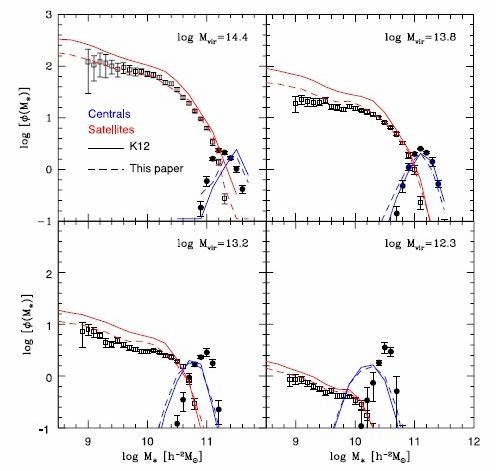Resolving the problem of galaxy clustering on small scales
2014-02-20Galaxy clustering sets strong constraints on the model of galaxy formation and the nature of dark matter. It is a long-standing problem that the predicted galaxy clusterings from semi-analytical models are often higher than the data on small scales. This problem intrigues modification to the parameters of standard LCDM (dark energy plus cold dark matter), such as the amplitude of density perturbation, the temperature of dark matter. However, this clustering problem is still not fully resolved.
Dr Xi Kang at the Purple mountain observatory has been working on the semi-analytical models and seeking the solution to this problem. The first step is to understand the discrepancy between different models on the predicted galaxy clustering. They firstly compare two similar semi-analytical models which are both improved version of the Munich models. One model could correctly reproduce the galaxy stellar mass function, but over-predict the clustering. One model highly over-predict the stellar mass function, but predicted a clustering more close to the data. Dr Xi Kang found that the latter model prediction comes as a coincidence actually, and the predicted clustering would be much higher if those over-predicted low-mass galaxies are randomly removed. Thus the galaxy clustering problem is real in current models, and it is mainly from the over-prediction of low-mass satellite galaxies in massive haloes.
To resolve the over-prediction of low-mass satellites, Dr Xi Kang modified the semi-analytical model of Kang et al. (2012) by incorporating a more reasonable feedback efficiency for supernova. In this new model, the cold gas in satellites are heated to the temperature of the subhalo associated with the satellites themselves, but that the host halo. This new model is able to predict the clustering on all scales for galaxy with different stellar mass (see the dashed line in Fig.1)
The paper is now published by the Monthly Notices of the Royal Astronomy Society (Feb 2014, Volume 437, page 3385-3395). This work is supported by the National Nature Science Foundation of China and the National basic research program of China.
For more reading, please refer to :

Fig.1: Projected galaxy clustering for low and high mass galaxies. Data points show the observation of SDSS, the solid lines are the model prediction of Kang et al. (2012), and the dashed lines are the new results in this work.

 Search
Search

